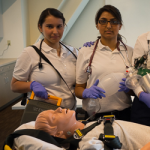What is an Optician?
Opticians are individuals who are qualified to dispense corrective eyewear.
They follow prescriptions from ophthalmologists or optometrists to help customers find the right pair of eyeglasses or contact lenses.
Their job description may also include cutting lenses into shapes, helping customers choose eyeglasses frames depending on their style and preferences, and keeping sales records.
According to the Bureau of Labor Statistics, opticians held around 73,800 jobs in the United States in 2019, most of them working in offices of optometrists or health and personal care stores.
Duties
Although job responsibilities vary depending on the place of employment and the size of the establishment.
Opticians usually do the following:
- Take prescriptions from customers
- Cut lenses into shape
- Measure the distance between eyes and other features to help customers choose the right pair of glasses
- Adjust the eyewear until it fits perfectly
- Create work orders about the type of lenses needed- these orders are afterward sent to laboratory technicians
- Repair broken eyeglasses frames
- Educate customers on how to maintain their eyeglasses and contact lenses.
- Keep records about sales and perform other business tasks.
Salary
The average annual salary reported by opticians in the United States was $37,570 as of May 2021 – which translates into $3,333 per month.
Salaries however vary depending on a wide range of factors, including experience level, place of employment, certifications, and the region of employment.
As an entry-level optician, your starting salary may be less than $28,910 but it will gradually increase as you become more experienced.
About 75 percent of all opticians who work in the United States make more than this amount and the top 10 percent make more than $60,280 annually.
As mentioned above, the region of employment is another important factor in determining an optician’s salary.
For example, opticians in Utah made less than $30,000 on average in 2019 while those in New Jersey made more than $60,000.
Other states where opticians reported average salaries that were above the $50,000 mark are Alaska, Connecticut, the District of Columbia, and New York but wages also vary depending on the city and the local economy.
Relocating to a region that offers higher salaries can help improve your salary prospects.
Salaries also vary depending on the industry of employment.
According to BLS, opticians who work for offices of other health practitioners reportedly earned $39,180 per year, on average (as of May 2020) while those who work for offices of physicians made $44,400.
The top-paying industry for this profession is wholesalers of professional and commercial equipment and supplies- a sector that hires only a few opticians and offers a median annual wage of $62,260.
Annually National Average Salary: $49,970
Average Annual Salary by State
| State | Avg. Annual Salary |
|---|---|
| Alabama | $36,750 |
| Alaska | $58,030 |
| Arizona | $49,940 |
| Arkansas | $47,370 |
| California | $59,000 |
| Connecticut | $65,550 |
| Delaware | $44,080 |
| District of Columbia | $60,580 |
| Florida | $54,980 |
| Georgia | $50,190 |
| Hawaii | $57,170 |
| Idaho | $44,510 |
| Illinois | $44,560 |
| Indiana | $39,780 |
| Iowa | $42,990 |
| Kansas | $40,590 |
| Kentucky | $46,290 |
| Louisiana | $37,320 |
| Maine | $47,510 |
| Maryland | $48,560 |
| Massachusetts | $65,400 |
| Michigan | $43,500 |
| Minnesota | $49,520 |
| Mississippi | $36,210 |
| Missouri | $44,340 |
| Montana | $45,700 |
| Nebraska | $40,970 |
| Nevada | $53,740 |
| New Hampshire | $51,690 |
| New Jersey | $65,020 |
| New Mexico | $38,880 |
| New York | $63,050 |
| North Carolina | $53,600 |
| North Dakota | $43,910 |
| Ohio | $48,420 |
| Oklahoma | $36,680 |
| Oregon | $59,810 |
| Pennsylvania | $45,190 |
| Rhode Island | $55,420 |
| South Carolina | $48,760 |
| South Dakota | $42,130 |
| Tennessee | $48,760 |
| Texas | $38,370 |
| Utah | $44,800 |
| Vermont | $61,420 |
| Virginia | $54,370 |
| Washington | $52,170 |
| West Virginia | $41,030 |
| Wisconsin | $44,630 |
| Wyoming | $39,440 |
| Puerto Rico | $30,190 |
Annual Average Salary: Top 5 States
The top earning state in the field is Connecticut, where the average salary is $65,550.
These are the top 5 earning states in the field:
* Employment conditions in your area may vary.
How to Become an Optician
Step 1 Complete a Post-Secondary Education Program
Many opticians learn the ins and outs of this profession through on-the-job training after finishing high school.
However, education requirements vary by state, and about half of all states require opticians to be licensed.
Some opticians learn the skills needed for this profession through post-secondary training at a technical school or community college.
If you want to become an optician, you can choose either a two-year program that offers an associate’s degree or a certificate
program that can be completed in less than 1 year.
Regardless of the type of program, schools usually mix classroom education with clinical hands-on training where students learn useful skills, such as how to measure a customer’s eyes or how to adjust eyeglass frames under the supervision of an experienced optician.
Training programs usually also cover sales and office-management classes.
Opticians can also learn through an apprenticeship which usually lasts 2 years and focuses mostly on hands-on training.
Step 2 Become Licensed
Not all states require opticians to be licensed, and it’s best to check the requirements that are applicable in your region with your state’s licensing board.
Licensure requirements vary but in most states, you need to complete an apprenticeship or another post-secondary program that is accredited by the appropriate institutes.
Another important requirement for licensure is to pass an exam that may consist of one or more tests and covers a variety of topics related to optics, eye anatomy, lenses, and measurements.
A way to improve your employment prospects is by becoming certified by the American Board of Opticianry (ABO) or National Contact Lens Examiners, or both.
Moreover, in most states, this certification can help you obtain a license.
Step 3 Renew Your License
Once you become licensed you will need to renew this credential every 1 to 3 years, depending on the state when you practice.
To do this, you will need to complete continuing education classes and prove that you have kept up to date with the latest advancements in the field.
Popular Programs
Education Requirements
As an optician, you will need at least a high school diploma or equivalent because most employers and post-secondary training programs require one of these credentials before admission.
To be able to help people find the eyeglasses and contact lenses they need, you will need some special skills that can be learned through a post-secondary program, on-the-job training, or an apprenticeship.
Some schools also offer online classes or hybrid classes that can be completed either part-time or full-time.
Regardless of the type of program you choose, there are a few important areas that you need to cover:
- Types of corrective eyewear
- How to adjust eyeglass frames
- Optics
- Anatomy of the eye
- Math
- Business classes
In addition, as an optician you will also need other skills:
- Communication skills – being able to listen to what customers need and informing them about their options is very important
- Business skills – opticians may also be responsible for inventory and other clerical duties
- Customer service skills – knowing the products that you sell and knowing how to sell them is very important in this line of work
- Dexterity – good eye-hand coordination and attention to detail are very important when using tools that adjust eyeglasses or contact lenses
Many programs also include a hands-on portion of training where you will get to apply what you learn in class and practice the skills needed for this profession but it’s best to read the program’s curriculum before enrollment.
Training costs can vary from less than $5,000 to more than $10,000 depending on the program you choose and the location.
Many schools charge lower tuition fees for in-state students.
After finishing your training you can apply for certification and/or licensure.
Depending on the states where you want to practice, you may be required to get a license before being eligible for employment.
You can choose to become certified in eyewear dispensing, in contact lenses dispensing or you can become certified in both areas by taking two exams administered by the
American Board of Opticianry- National Contact Lenses Examiners (ABO-NCLE).
These credentials can be earned by passing exams that are offered during four testing windows year-round.
According to ABO-NCLE’s website in 2019, approximately 57.8% of candidates passed the ABO Basic Examination while the NCLE exam had a pass rate of 59.5%.
Video About The Career
Certification Requirements
As mentioned above, not all states require opticians to hold a license or certification but in some regions, you need to be licensed before being allowed to practice.
Many states require candidates to pass the American Board of Opticianry (ABO) or the National Opticianry Competency Exam as part of their licensing process but you should check the requirements that are applicable in your state before signing up for this.
Before taking these exams you will also have to pay an exam fee which, is $225 for the ABO exam.
The exams cover topics such as:
- Terminology
- Prescriptions
- Lens characteristics, materials, powers, and types
- Effects of lenses
- Lens options
- Measurement systems and conversions
- Neutralization of lenses
- Ophthalmic formulas
- Ocular anatomy, physiology, pathology, and refraction
- Ophthalmic products
- Instrumentation for measurement and observation
- Dispensing procedures
- Laws, regulations, and standards
- Refractive errors
- Prefitting
The exams are 2 hours long and are available in English and Spanish.
To be eligible for the ABO exam you need to be over 18 years of age and have a high school diploma or GED but some states may have additional requirements for licensure.
Even if there are no education or experience requirements, candidates who have some work experience in the field or have graduated from a post-secondary optician training program are usually more successful in passing the exam, according to ABO’s website.
To maintain your license you will need to participate in continuing education classes and renew your certification every 1 to 3 years.
Average Training Program Duration: 1-2 Years
Job Outlook
According to the Bureau of Labor Statistics, employment for opticians is projected to grow 6 percent from 2019 to 2029.
As the population ages, the demand for eye care services is projected to grow.
The increasing rate of diabetes and other chronic diseases that cause vision problems is expected to lead to a greater demand for corrective eyewear.
However, for better-paying jobs, the competition is expected to be strong and you can improve your employment prospects by becoming certified, even if you reside in a state where certification is not a requirement.
Employment Growth Projection: 3%
2023
2033
That's a higher than average projected growth of 2,200
Should You Become an Optician?
Overall Satisfaction: Medium

What makes people satisfied about the professional path they are choosing?
Many factors can determine if a career is fulfilling or not.
Things such as salary, work environment, stress, skills, meaning, and personality compatibility are usually taken into account when someone decides if they are happy or not with the path they’ve chosen.
According to CareerExplorer, the average career happiness reported by opticians is 2.9 out of 5 stars- which puts this career in the bottom 23% of all careers.
Even if the level of professional satisfaction reported by opticians is low, if you’re passionate about optics, sales and you enjoy interacting with people, this can be a rewarding and lucrative career for you.
Average Salary: Low

According to the Bureau of Labor Statistics, the median annual salary reported by opticians in the United States was 37,570 as of 2021- which means that half of all workers in this profession earned less than this amount while half earned more.
Salaries are influenced by a variety of factors, including the worker’s level of experience, education, and region of employment.
The lowest 10 percent of all opticians earned less than $28,910 while the top 10 percent made more than $60,280 per year.
However, salaries are also determined by the region of employment, level of experience, local economy-among other factors.
If you’re willing to relocate to a large city where you can find employment in a luxury clinic, you may earn a higher-than-average salary but you should also take into account additional living expenses.
Job Growth Outlook: Medium

If you want to start a career as an optician your job prospects are looking good, especially if you have completed some post-secondary education or if you hold a certificate in the field.
This career is projected to grow 6 percent from 2019 to 2029, according to the Bureau of Labor Statistics, about as fast as the average for all occupations.
This growth will be tempered by the fact that technology leads to an increase in productivity which reduces the number of opticians that are needed to serve a certain number of customers.
Becoming certified in both eyewear and contact lenses dispensing can improve your employment prospects.
Education Duration: 1-2 Years

Depending on the institution and the type of program you choose, optician-training programs can last from a few months to two years.
Some opticians learn this trade through a 2 years apprenticeship or associate degree program while others enroll in a 1-year certificate program.
Part-time programs are also available so the program length varies depending on your schedule and how much time you can dedicate to your studies.
Personal Skills Needed

To be able to perform well at your job, as an optician you need both technical and communication abilities.
Other personal skills opticians need:
- Customer-service skills
- Dexterity
- Attention to detail
- Ability to multitask
- Understanding of sales terminology
- Business skills
- Physical stamina
- The ability to read doctor’s prescriptions
Frequently Asked Questions
How Much Training Does an Optician Need?
Education and licensure requirements vary depending on the state where you want to practice.
To have the best employment prospects as an optician you will need a high school diploma and a degree or certificate from a post-secondary education program or an apprenticeship.
The training period usually lasts from 1 to 2 years.
Many programs combine classroom education with hands-on training and some also offer online classes.
About half of US states require opticians to hold a license.
This license can be earned after completing the education requirements that are applicable in your state and passing an exam.
What Does an Optician Do?
Opticians make, sell and repair eyeglasses and some of them also dispense contact lenses.
Their job description also includes advising clients and completing business tasks, such as keeping records of sales.
Most of them work in offices of optometrists or health and personal care stores.
The exact job responsibilities vary depending on the optician’s level of expertise and the size of the business.
Some opticians are qualified for both eyeglass and contact lenses dispensing while other focus only on one type of corrective eyewear.
In small businesses opticians also cover the clerical aspects of eyewear dispensing while larger establishments hire multiple individuals, each with their job description.
How Much Does It Cost to Become an Optician?
Training costs vary widely depending on the school and the length of the program.
Some programs cost less than $5,000 while others are more than $10,000.
Many schools offer lower tuition rates for in-state students.
If you want to become a certified optician or you leave in an area where such certification is required, you should also take into account the cost of the exam.
The fee for the Basic Certification Exams offered by the American Board of Opticianry & National Contact Lenses Examiners is $225 per exam.
If you enroll in a program that is in a different city, then you should also take into account housing or travel costs.
What Is the Demand for Opticians?
According to the Bureau of Labor Statistics, this profession is projected to grow 6 percent from 2019 to 2029.
This growth is explained in part by the fact that the aging population will need eye care services and corrective eyewear more often.
Opticians who have a few years of experience and good customer service skills and those who are certified are expected to have the best job prospects.
Where Can I Find Employment as an Optician?
According to the Bureau of Labor Statistics, most opticians work in offices of other health practitioners or in health and personal care stores.
Opticians also work in offices of physicians, outpatient care centers, or hospitals.
Other sectors, such as colleges, schools, and manufacturers of medical equipment and supplies also hire opticians but job openings don’t occur very often and a college degree or additional certifications may be required.
 Optician Info by State
Optician Info by State

- Alabama
- Alaska
- Arizona
- Arkansas
- California
- Colorado
- Connecticut
- Delaware
- Florida
- Georgia
- Hawaii
- Idaho
- Illinois
- Indiana
- Iowa
- Kansas
- Kentucky
- Louisiana
- Maine
- Maryland
- Massachusetts
- Michigan
- Minnesota
- Mississippi
- Missouri
- Montana
- Nebraska
- Nevada
- New Hampshire
- New Jersey
- New Mexico
- New York
- North Carolina
- North Dakota
- Ohio
- Oklahoma
- Oregon
- Pennsylvania
- Rhode Island
- South Carolina
- South Dakota
- Tennessee
- Texas
- Utah
- Vermont
- Virginia
- Washington
- West Virginia
- Wisconsin
- Wyoming
Optician Resources
- 14 Pros and Cons of Being an Optician
- ABO Certification for Opticians
- Careers for Opticians: Here’s What You Need to Know
- Certification for Opticians
- How Much Does Optician School Cost?
- Online Optician Training Programs
- Optician VS Optometrist: What’s The Difference?
- What Does an Optician Do?
- What is an Ophthalmic Assistant?
More Medical Careers
| Career | |
|---|---|
 | Certified Nursing Assistant Working as a Certified Nursing Assistant is an entry-level role that will give you hands-on experience when you are ready to take the next step in your medical career. |
 | Dental Assistant Dental assistants help dentists to provide patient care, keep records, and care for the dental equipment. |
 | Dental Hygienist Dental hygienists take care of cleaning teeth to promote hygiene and help avoid cavities and gum problems. |
 | Dialysis Technician Dialysis technicians maintain and monitor dialysis equipment, and also act as primary caregivers for patients undergoing dialysis treatment. |
 | Dog Groomer Dog groomers attend to grooming dogs, usually at dog salons or big pet-related chain stores. |
 | Healthcare Administrator Healthcare administrators – also known as healthcare executives or health services managers – are responsible for the planning, direction, and coordination of medical and health services. |
 | Home Health Aide Home health aides provide home care to individuals who require assistance in their day-to-day living. |
 | Licensed Practical Nurse (LPN) Licensed Practical Nurses provide basic nursing care to patients and work with Registered Nurses and Doctors. |
 | Medical Assistant Medical assistants support the work of physicians, nurses, and other health professionals. |
 | Medical Biller and Coder Medical billers and coders manage, organize, and code various health information data. |
 | Medical Technologist Medical laboratory technologists collect bodily samples and conduct tests to analyze those samples. |
 | Medical Transcriptionist Medical transcriptionists go over voice recordings to convert them into written texts. |
 | Nutritionist As a Nutritionist, you’ll be tasked with creating meal plans, counseling, and understanding dietary restrictions for all types of clients. |
 | Patient Access Representative The work involves helping people to orient themselves to the space and everything that is going on. |
 | Patient Care Technician Patient care techs work directly with patients helping them with daily activities and assist the medical staff by measuring and monitoring the patients' vital signs among other tasks. |
 | Pharmacy Technician Pharmacy technicians provide patients with medications through prescription or over the counter. |
 | Phlebotomist As a Phlebotomist, it will be your responsibility to take blood samples from patients and send them to the lab for further testing. |
 | Physical Therapist Assistant Physical therapist assistants provide physical therapy services to patients and aide to physical therapists. |
 | Professional Recovery Coach A professional recovery coach is a life coach who works with someone during their addiction recovery process. |
 | Radiation Therapist Allied health provisional who specializes in radiation oncology treatments. |
 | Registered Health Information Technician Registered Health Information Technician (RHIT) help store and verify accuracy of health records as well as analyze patient data. |
 | Registered Nurse (RN) Registered Nurses provide hands-on patient care in various settings, mainly hospitals, and clinics. |
 | Respiratory Therapist Respiratory therapists treat and care for patients who experience breathing difficulties. |
 | Sterile Processing Technician A sterile processing technician is a healthcare professional who is responsible for preparing, sterilizing, maintaining, packaging, and storing medical tools and equipment used in surgical and other medical procedures. |
 | Surgical Technologist Surgical technologists – also known as operating room techs – prepare operating rooms and assist doctors and nurses during surgical procedures. |
 | Vet Office Manager Veterinary office managers work to make sure that the daily operations run smoothly and efficiently at veterinary hospitals or veterinary clinics. |
 | Veterinary Assistant Veterinary Assistants work closely with Veterinarians to handle routine animal care. |
 | Veterinary Technician Veterinary Technicians assist veterinarians as well as diagnosing and treating animals, mostly in private clinics. |
 | EKG Technician EKG technicians test and monitor the cardiovascular system. |
 | EMT Trained emergency medical technician that arrives at the scene to provide medical services such as resuscitation. |
 | MRI Technologist MRI Technologists use a machine to scan the body and create a detailed image of the inside for doctors to analyze. |
 | Ultrasound Technician Ultrasound technicians aid physicians in monitoring and diagnosing patients through the use of ultrasonic imaging technology. |
 | X-Ray Technician X-Ray Technicians are medical imaging professionals who use technology to visualize the inside of our bodies. |














